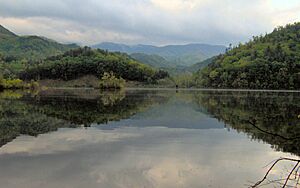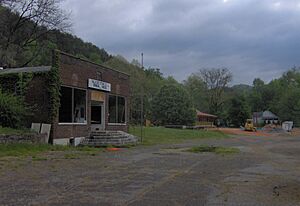Tallassee (Cherokee town) facts for kids
Tallassee (also spelled Talassee or Talisi) was an important Native American site in what is now Tennessee, in the southeastern United States. It was home to people long ago and later to the Overhill Cherokee tribe. Tallassee was the town furthest south along the lower Little Tennessee River in the 1700s. Even though old records don't talk much about it, Tallassee appeared on every main map of the Little Tennessee Valley from that time.
Archaeologists dug up the site in the 1950s before a dam was built. They found signs that people lived there as far back as 1000 BC. The site was also used throughout the Mississippian culture period, from 900 to 1600 AD. They found a large mound built around 1000 AD. For the Cherokee period, they found over 24 burials with items showing trade with Europeans. They also found old trash pits and parts of a burned house.
Today, the Tallassee site is underwater, covered by Chilhowee Lake. This lake was made when the Chilhowee Dam was finished in 1957. The land around the old site is now part of the Calderwood Hydroelectric Development Area. This area was set up by the Aluminum Company of America in the 1920s. It was a base for building other dams further upriver.
The small town of Tallassee that exists today was built much later, in the early 1900s. It is about 7 miles (11 km) downstream from the ancient site, near Chilhowee Dam.
Contents
Where is Tallassee Located?
The Little Tennessee River starts in the mountains of Georgia and North Carolina. It then flows into Tennessee for about 54 miles (87 km) before joining the Tennessee River. Chilhowee Dam is about 34 miles (55 km) from where the river meets the Tennessee River. This dam created a lake that stretches 10 miles (16 km) upriver to the Calderwood Dam.
The ancient Tallassee site was located about 41.5 miles (66.8 km) upriver from the Tennessee River. It was right where Tallassee Creek flows into the Little Tennessee River. Old records from the 1700s say the town was on both sides of the river. Calderwood Dam is only about 2 miles (3.2 km) upstream from where Tallassee used to be.
Tall mountains surround the Tallassee site. The Great Smoky Mountains are to the north and east. The Unicoi Mountains are to the south and west. The Little Tennessee River forms the border between the Great Smoky Mountains National Park and the Cherokee National Forest.
The Calderwood Hydroelectric Development Area is on the shores above the old Tallassee site. You can reach it from U.S. Route 129, about 6 miles (9.7 km) south of the Foothills Parkway.
History of the Tallassee Site
Because Tallassee was in a remote mountain area, not many explorers or traders visited it in the 1700s. However, the village appeared on George Hunter's 1730 map of the Cherokee country. It was shown alongside other important towns like Citico and Tanasi.
In 1725, the leader of Tallassee met with Colonel George Chicken. They met at the Tanasi townhouse to form an alliance against the Creek. Tallassee also appeared on Henry Popple's 1733 map of the British Empire in North America. In 1751, South Carolina records listed Tallassee as one of seven Overhill towns. These same seven towns were on John Mitchell's 1755 map of North America. Europeans called settlements with a townhouse a "Cherokee town." A townhouse was a public meeting place for the community and where they welcomed visitors.
In 1761-1762, Henry Timberlake visited the Overhill towns. He was a British envoy on a peace tour after the Anglo-Cherokee War. He drew a map showing Tallassee with a townhouse and 22 homes. Fifteen homes were on the east side of the river, and seven were on the west side. He also noted that Tallassee had 47 warriors. This was the third-smallest group of warriors he listed in the valley. Timberlake also wrote that Tallassee's "governor" had recently died and had not yet been replaced.
The Cherokee–American wars happened in the late 1700s. These wars led to the destruction of most Overhill towns. In 1776, Colonel William Christian invaded the Overhill country. He destroyed many towns but spared Tallassee. In 1780, a group of soldiers tried to burn Tallassee but couldn't cross the river.
Finally, in 1788, John Sevier's forces burned Tallassee. This was in response to what settlers called the Nine Mile Creek massacre. The village was attacked again in 1795 by Colonel Alexander Kelley, and 8 villagers were killed. The Cherokee left Tallassee in 1819 after signing the Treaty of Calhoun. This treaty gave the Little Tennessee Valley to the United States. For much of the 1800s and early 1900s, Tallassee was a river crossing connecting two important roads.
Modern Tallassee Town
In the early 1900s, a train station called Tallassee was built. It was about 7 miles (11 km) downstream from the old village, near the modern Chilhowee Dam. Around 1928, some investors tried to build a mountain resort there. They built and sold cabins, but the project didn't work out. A small community still exists at this new Tallassee. The Tellico Reservoir Development Agency has built a boat ramp there for people to access the river.
Archaeological Discoveries
When Alcoa announced plans to build Chilhowee Dam in 1955, archaeologists began digging. The Knoxville Chapter of the Tennessee Archaeological Society, with help from the University of Tennessee, started rescue digs. They focused on the Chilhowee and Tallassee sites, which would soon be underwater. Since few artifacts were found at Chilhowee, they focused more on Tallassee.
The items found at Tallassee showed that people lived there off and on for a very long time. This includes the Woodland period (1000 BC – 1000 AD) and the South Appalachian Mississippian culture period (900 – 1600 AD). Archaeologists found a large platform mound on the east side of the river. This mound was built by people who lived there long before the Cherokee.
They also found 145 burials at Tallassee. Twenty-seven of these were from the historic Cherokee period. The items buried with the Cherokee included glass trading beads, iron tools, and brass items. These show that they traded with Europeans. They also found copper arrowheads and a jaw harp. The archaeologists also uncovered 18 trash pits, parts of a burned house, and the foundations of a cabin from the early 1800s.





